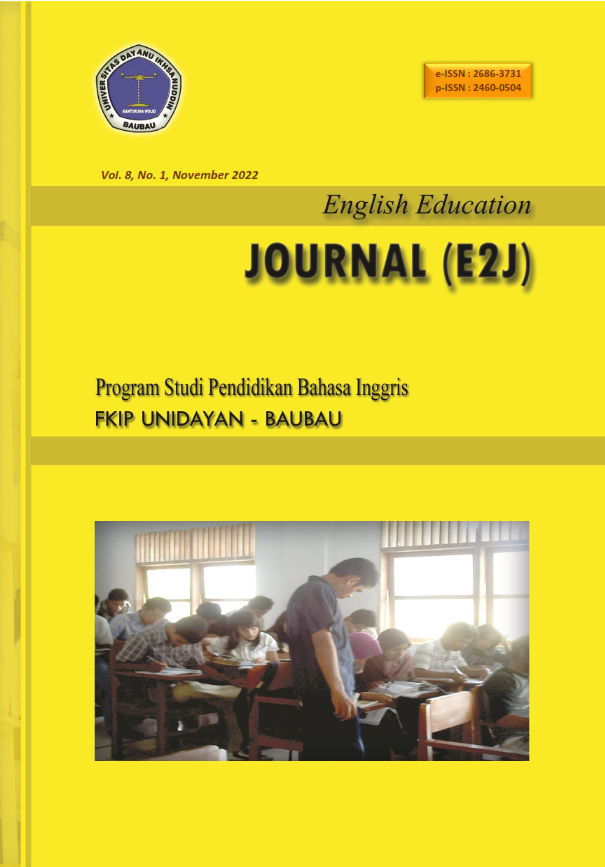WHATSAPP AS LEARNING MEDIA DURING COVID-19 PANDEMIC IN LEARNING PROCESS OF ENGLISH SUBJECT AT SMAN 5 BAUBAU
DOI:
https://doi.org/10.55340/e2j.v8i1.856Kata Kunci:
English Learning Media, WhatsApp GroupAbstrak
During the pandemic Covid-19, among the many long-distance communication applications, the teachers at SMAN 5 Baubau choose Whatsapp Group as learning media which could be used on weak networks and also does not consume internet quota like the others. The objectives of this study was to find the using of this application as a learning media at SMAN 5 Baubau and the impact of this application on the distance learning process during the covid-19 pandemic.
The present study used qualitative method. This research carried out in June - December 2020 at SMA Negeri 5 Baubau. The subjects in this study were 18 students at SMA Negeri 5 Baubau with details of Class X (6 people), Class XI (6 people) and Class XII (6 people). The instruments used in this research was interview. The findings showed that the majority of students did not have problems or obstacles in using this application. However, some students found it difficult in the learning process that depends on the chat in the group. Although students did not have obstacles in operating the application, but as a medium of learning students had many obstacles and WhatsApp as a learning medium would be more complicated if it is not supported by the creativity of the teacher.
Unduhan
Referensi
M. Ediyani, U. Hayati, S. Salwa, S. Samsul, N. Nursiah, and M. B. Fauzi, “Study on Development of Learning Media,” Budapest Int. Res. Critics Inst. Humanit. Soc. Sci., vol. 3, no. 2, pp. 1336–1342, 2020, doi: 10.33258/birci.v3i2.989.
W. K. Koomson, “MOBILE LEARNING : APPLICATION OF WHATSAPP MESSENGER AS A LEARNING TOOL IN A UNIVERSITY DISTANCE LEARNING PROGRAM IN GHANA,” no. Celda, pp. 45–52, 2018.
D. Suriyani Djamdjuri and A. Kamilah, “WHATSAPP MEDIA IN ONLINE LEARNING DURING COVID-19 PANDEMIC,” ENGLISH J., vol. 14, no. 2, p. 69, 2020, doi: 10.32832/english.v14i2.3792.
M. Kristiawan, “A Model for Upgrading Teachers’ Competence on Operating Computer as Assistant of Instruction,” Glob. J. Human-Social Sci. G, vol. 14, no. 5, pp. 42–55, 2014.
U. S. Sa’ud, Inovasi Pendidikan. Bandung: Alfabeta, 2008.
Hartoyo, Teknologi Informasi dan Komunikasi (TIK) dalam Pembelajaran Bahasa. Semarang: Pelita Insani Semarang, 2012.
E. Sawitri, M. S. Astiti, and Y. Fitriani, “Hambatan Dan Tantangan Pembelajaran Berbasis Teknologi Informasi Dan Komunikasi,” Pros. Semin. Nas. Pendidik. Progr. Pascasarj. Univ. PGRI Palembang, pp. 202–213, 2019.
A. P. Gilakjani, “A Detailed Analysis over Some Important Issues towards Using Computer Technology into the EFL Classrooms,” Univers. J. Educ. Res., vol. 2, no. 2, pp. 146–153, 2014, doi: 10.13189/ujer.2014.020206.
E. Djumena, “Android Terus Melaju di Indonesia,” Tekno Kompas, Nov. 2010.
L. T. Prawanti and W. Sumarni, “Kendala Pembelajaran Daring Selama Pandemic Covid-19,” Pros. Semin. Nas. Pascasarj. UNNES, pp. 286–291, 2020.
M. B. Milles and M. Huberman, Analisis Data Kualitatif Terjemahan oleh Tjetjep Rohendi. Jakarta: UI-Press, 1992.
Y. D. Puspitarini and M. Hanif, “Using Learning Media to Increase Learning Motivation in Elementary School,” vol. 4, no. 2, pp. 53–60, 2019.
S. Maheasy, “The Role of Media in Indonesian Language Learning in Schools,” vol. 19016122, 2020.
Tileston, “The Importance of Media in the Classroom,” vol. 09, pp. 1–7.
T. R. M. Joan Dabrowski, “Motivation and Engagement in Student Assignments :”.
M. D. Rawat, “IMPORTANCE OF COMMUNICATION IN TEACHING LEARNING PROCESS Ms Deepti Rawat Research Scholar Shobhit University Meerut,” pp. 3058–3063.






















